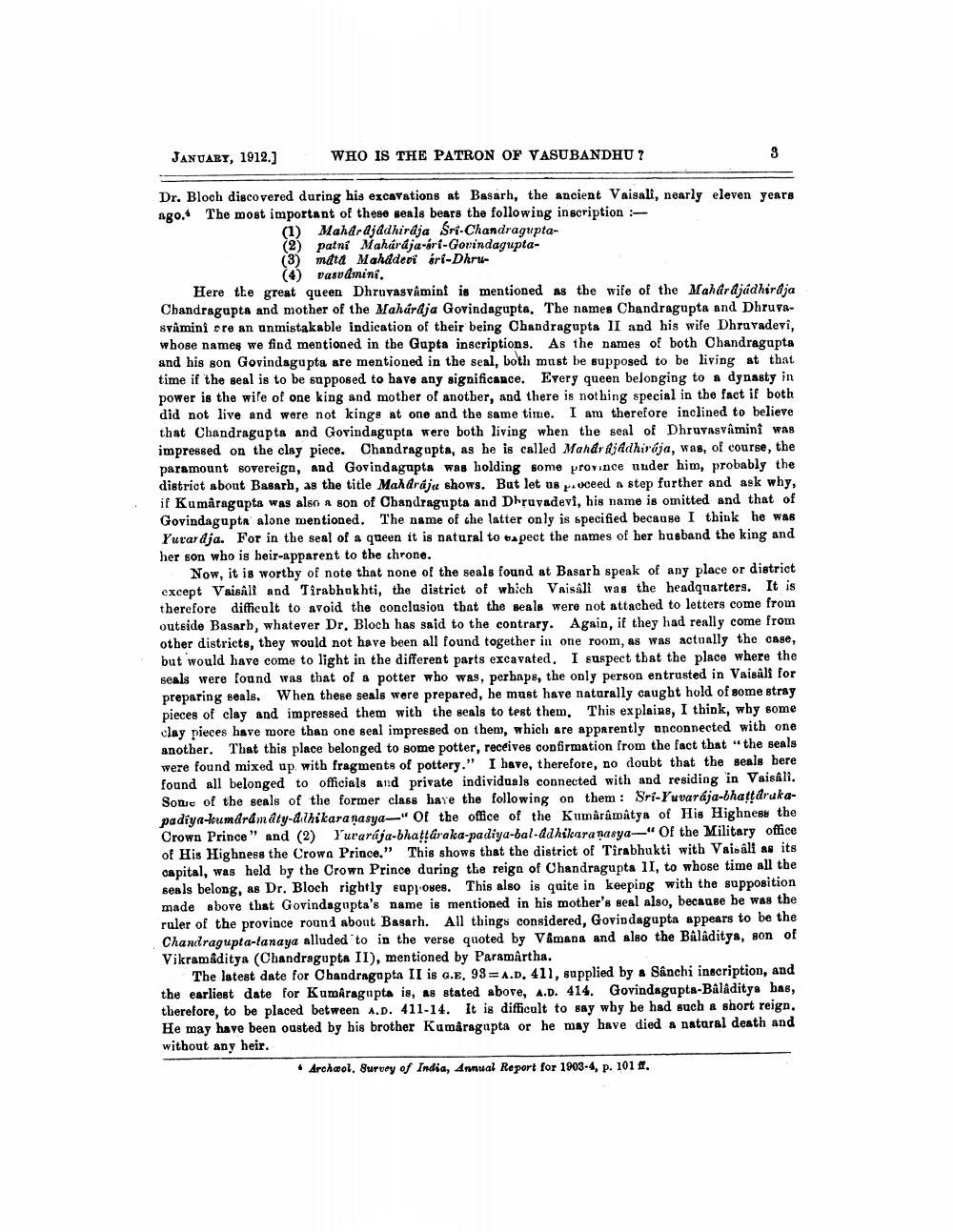Book Title: Indian Antiquary Vol 41 Author(s): Richard Carnac Temple, Devadatta Ramkrishna Bhandarkar Publisher: Swati Publications View full book textPage 7
________________ JANUARY, 1912.) WHO IS THE PATRON OF VASUBANDHU ? Dr. Bloch discovered during his excavations at Basarh, the ancient Vaisali, nearly eleven years ago. The most important of these seals bears the following inscription - (1) Maharajadhirdja Sri-Chandragupta(2) patni Mahárája-sri-Govindagupta(3) mata Mahddedi éri-Dhru (4) vasvamini. Here the great queen Dhruvasvamint is mentioned as the wife of the Mahardjádhiraja Chandragupta and mother of the Mahardja Govindagupta. The names Chandragupta and Dhruvasvâmini cre an unmistakable indication of their being Chandragupta II and his wife Dhruvadevi, whose names we find mentioned in the Gupta inscriptions. As the names of both Chandragupta and his son Govindagupta are mentioned in the seal, both must be supposed to be living at that time if the seal is to be supposed to have any significance. Every queen belonging to a dynasty in power is the wife of one king and mother of another, and there is nothing special in the fact if both did not live and were not kings at one and the same time. I am therefore inclined to believe that Chandragupta and Govindagupta were both living when the seal of Dhruvasvamini was impressed on the clay piece. Chandragupta, as he is called Maharajadhirója, was, of course, the paramount sovereign, and Govindagapta was holding some province nuder him, probably the district about Basarh, as the title Maharaja shows. But let us pecceed a step further and ask why, if Kumâragupta was also a son of Chandragupta and Dhruvadevi, his name is omitted and that of Govindagupta alone mentioned. The name of the latter only is specified because I think he was Yurar dja. For in the seal of a queen it is natural to tapeet the names of her husband the king and her son who is heir-apparent to the chrone. Now, it is worthy of note that none of the seals found at Basarh speak of any place or district except Vaisali and Tirabhakhti, the district of which Vaisali was the headquarters. It is therefore difficult to avoid the conclusion that the seals were not attached to letters come from outside Basarb, whatever Dr. Bloch has said to the contrary. Again, if they had really come from other districts, they would not have been all found together in one room, as was actually the case, but would have come to light in the different parts excavated. I suspect that the place where the seals were found was that of a potter who was, perhaps, the only person entrusted in Vaisali for preparing seals. When these seals were prepared, he must have naturally caught hold of some stray pieces of clay and impressed them with the seals to test them. This explains, I think, why some clay pieces have more than one seal impressed on them, which are apparently unconnected with one another. That this place belonged to some potter, receives confirmation from the fact that the seals were found mixed up with fragments of pottery.” I have, therefore, no doubt that the seals bere found all belonged to officials and private individuals connected with and residing in Vaisali. Sonic of the seals of the former class have the following on them : Sri-Yuvarája-bhattdrukapadiya-loumdrámaty-dihikaranasya—" of the office of the Kumârâmâtys of His Highness the Crown Prince" and (2) Yurarája-bhattaraka-padiya-bal-adhikaraṇasya--"Of the Military office of His Highness the Crown Prince." This shows that the district of Tirabhukti with Vaisali as its capital, was held by the Crown Prince during the reign of Chandragupta II, to whose time all the seals belong, as Dr. Bloch rightly eap ones. This also is quite in keeping with the supposition made above that Govindagupta's name is mentioned in his mother's seal also, because he was the ruler of the province round about Basarh. All things considered, Govindagupta appears to be the Chandragupta-tanaya alluded to in the verse quoted by Vámana and also the Bâlâditya, son of Vikramaditya (Chandragupta II), mentioned by Paramartha. The latest date for Chandragupta II is G.E. 93=A.D. 411, supplied by a Sânchi inscription, and the earliest date for Kumâragupta is, as stated above, A.D. 414. Govindsgupta-Bâlâditya bas, therefore, to be placed between A.D. 411-14. It is difficult to say why be had such a short reign, He may have been ousted by his brother Kumâragupta or he may have died a natural death and without any heir. • Archæol. Survey of India, Annual Report for 1903-4, p. 101 1.Page Navigation
1 ... 5 6 7 8 9 10 11 12 13 14 15 16 17 18 19 20 21 22 23 24 25 26 27 28 29 30 31 32 33 34 35 36 37 38 39 40 41 42 43 44 45 46 47 48 49 50 51 52 53 54 55 56 57 58 59 60 61 62 63 64 65 66 67 68 69 70 71 72 ... 320
